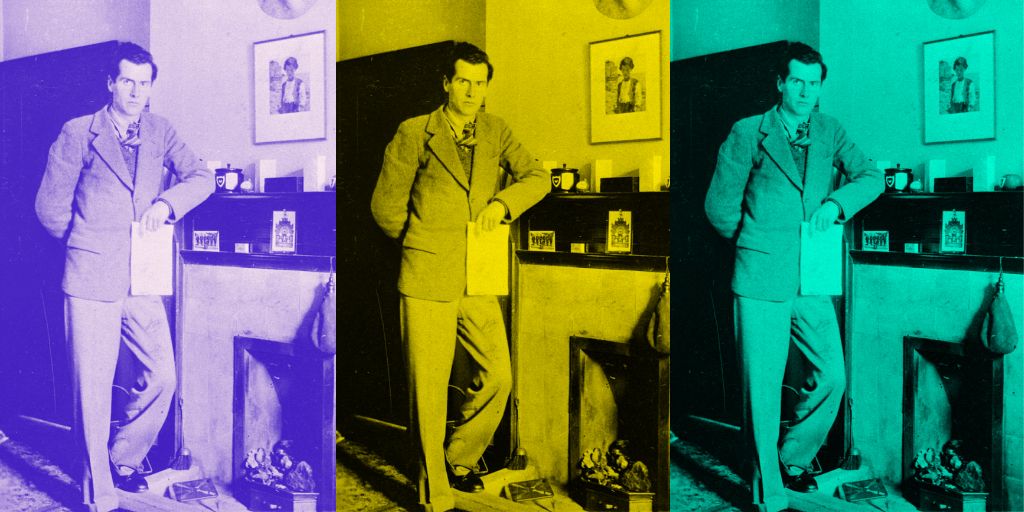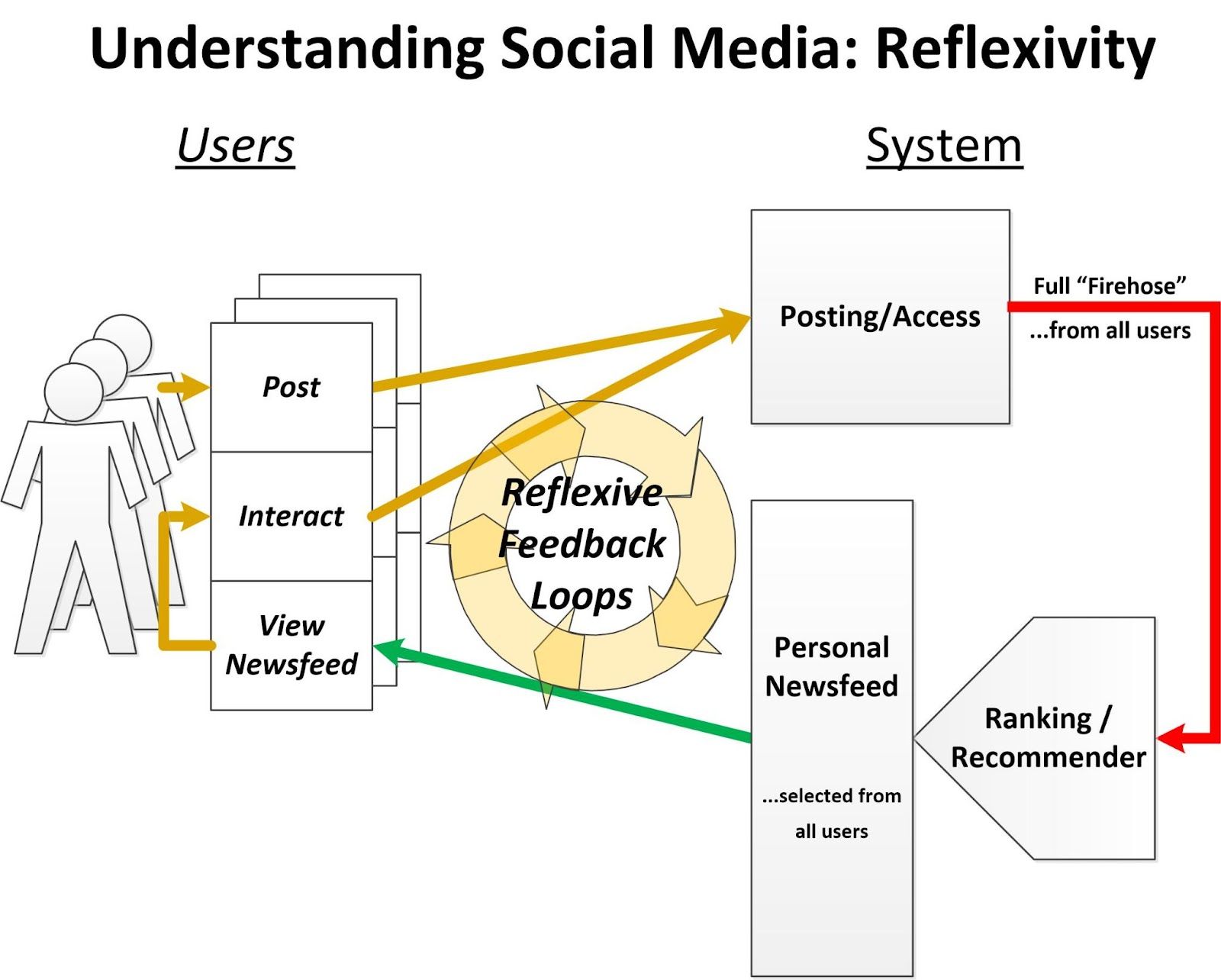Understanding Social Media: An Increasingly Reflexive Extension of Humanity
Richard Reisman, Chris Riley / Apr 27, 2022Richard Reisman is an independent media-tech innovator and frequent contributor to Tech Policy Press; Chris Riley is senior fellow for internet governance at the R Street Institute.

“We shape our tools and thereafter our tools shape us” – this idea of reflexivity is essential to understanding social media.
The promise of social media seemed obvious a decade ago; but in the years since, as The New York Times put it, “the internet didn’t turn out the way we hoped.” Former President Barack Obama articulated a similar idea in an address at Stanford last week, noting that “our new information ecosystem is turbocharging some of humanity’s worst impulses.”
But just as it has become clear that social media is not an unalloyed good in the world, it is also apparent that mitigating harm online is not as simple as more or better content moderation. Social media do not behave like other media. Speech is not primarily broadcast, as through megaphones and amplification but rather, propagates more like word-of-mouth, from person to person. Feedback loops of reinforcing interactions by other users can snowball, or they can just fizzle out if ignored. Understanding how to modulate the harmful aspects of these wild messaging cascades requires stepping back and, instead of viewing the messages as individual items of content, seeing them as stages in reflexive flows in which we and these new media tools shape each other.
In a prior essay in Tech Policy Press, we emphasized the notion of delegation as a means of promoting individual human agency and protecting a freedom of impression, built on the assertion that increased reflexivity in the internet environment demands management of flow, not just content. In this piece, we connect the centrality of user choice and agency to the deeper social and human substrate that underpins the potential of modern social technologies to bring positive new dynamics into our human interaction. We then look ahead to seek a productive path forward that can address both the present and future challenges of social media.
The mid-20th century Canadian scholar Marshall McLuhan spurred the field of media theory with his book, Understanding Media: The Extensions of Man. McLuhan defines media broadly to include a full range of technologies as tools (even clocks and electric lights), working as languages with new structures and grammars, and having the effects of shaping and re-shaping how individuals and societies see and understand their worlds. While McLuhan’s work has plenty of critics, it catalyzed thinking about media ecology – an area of study of media and communications technology focusing on human environments and complex systems.
Media ecology may seem abstract compared to the concrete and immediate harms of violence and misinformation online. Yet its central lessons offer essential context for defining problems clearly and evaluating proposed solutions. Modern media increasingly does more than merely reflect the world it presents – it shapes it, such that content and context are inextricably interwoven, and the result is a reflexive chain of collaborative transformation.
Reflect and reflex
Digital media can be a tool for amplifying a message to help it reach a larger number of people than a speaker acting alone could achieve. But the idea of linear amplification in the context of social media, and particularly regarding the kinds of virality that can create the greatest harm, oversimplifies and misleads toward faulty solutions. Social media virality flows more like rumors, relayed step by step – as depicted in the helpful diagrams of Renée DiResta and Tobias Rose-Stockwell (as below, showing a left to right timeline view).

Source: Renée Diresta and Tobias Rose-Stockwell, “How to Stop Misinformation Before It Gets Shared,” Wired, March 26, 2021. .
…and this one by Reisman emphasizing the circular flow of reflexive feedback loops.

As McLuhan famously said, “the ‘message’ of any medium or technology is the change of scale or pace or pattern that it introduces into human affairs” – with attendant “psychic and social consequences.” For fundamentally collaborative media, then, the collaboration is the message. And because social collaboration is inherently reflexive, the reflexivity is the message. (The social theory of reflexivity, as self-aware circularity of cause and effect, provides a rich, multidisciplinary perspective – see, for example, the Wikipedia backgrounder.) In other words, we shape our social media – as do all of those who interact with and propagate each message – and, thereafter, our social media shape us.
In prior media paradigms, this inherent reflexivity was slow-building, reflecting the pace of the offline social structure around the media. As networks and hierarchies rose and fell amid power struggles and radical technological innovations, the institutions of mediation, while first disrupted, evolved and re-formed over decades to serve a restructuring, legitimizing, and authorizing function. Notably, they imposed processes of reflection and independent evaluation as a prerequisite to amplification and reputation building. The result was an association of positive value with a dialectic and diversity of viewpoint, as hosted by a broad range of institutions.
Reflexive recommendation
But in this newly reflexive information flood, where the reduced cost of information production and distribution results in every individual having access to far more content than they could ever want or consume, media becomes dependent on mediating technical layers to filter and prioritize content and is transformed by human input along each propagation path. A firehose of “free speech,” without any form of filter, rapidly becomes useless for human consumption. Consider an email inbox without spam filtering or browsing the modern web without a search engine or curated links.
This filtering function consists of ranking and recommendation in various forms, through systems in which the private sector has invested billions of dollars of algorithm design and machine learning to develop and tune, which draw from the decisions and actions of millions of human users. This new class of selection intermediaries breaks the pairing of sender and receiver, of speaker and audience, that characterize traditional and mass media – now replaced by an interactive flow process that dynamically assembles an open-ended set of mutually interacting users.
The omnipresence of ranking and recommendation systems has dramatically increased the reflexivity of modern media, so far with little attention to its dangers and how to limit them. The cycle of selection and feedback that emerges from user-engagement actions is automated, instant, and global, and it often collapses context and identity, destroys nuance, and incentivizes performative behavior. Reducing friction increases engagement but impedes consideration and deliberation and, ultimately, fidelity. Worse yet, this reflexive propagation empowers insidious new forms of propaganda (“ampliganda”) that extend “reflexive control” strategies “focused on the destabilisation of perceptions of reality and recruit[ing] users in the construction of new politically useful realities.”
This new world of reflexivity and explosive reach that deeply interrelates “media contents and media infrastructure” in “deep mediatization” makes effective moderation intractable at scale. Combining artificial intelligence with human review is potentially powerful, but focusing it on content alone is fundamentally limiting. The net result is an internet ecosystem in which harm and unpleasantness seem ubiquitous, despite massive, ongoing “trust and safety” investments by its service providers. As Obama put it, “social media has a grimness to it.” Progress and experimentation continue, though, such as the growing attention to contextual metadata like external indicators of quality as well as flow and reaction signals. Use of such signals might help better modulate not just the pace, but also the shape of reflexivity, and might bend it toward the “better angels of our nature."
From multimedia to pan-media
Two current trends all but ensure that the upward, hockey-stick curve of reflexivity will not slow on its own. The first is the continued disintermediation and degradation of institutions that “once served as a kind of communal glue,” providing signals of authority and legitimacy to specific individuals or content. While this remains the current trajectory, there is both need and opportunity to change the path. The internet need not be an enemy of journalism per se, but the reality is that the old business models of news are still slouching toward some barely seen second coming, and public trust in authority in general is in decline. That second coming may perhaps be found in community and the sustaining support it motivates; for, as Filipino journalist and Nobel Prize winner Maria Ressa said, “If people can’t tell what’s true, it’s going to be who you like.” Even that new shared purpose of journalism and social media, though, will be mediated and thus subject to accelerating reflexivity.
A related aspect of this path is the shift toward increasing the scale and integration of social media systems, resulting in the paradoxical idea of a “public square” on a global scale. Some aspects of this were brought to a head by Elon Musk’s bid for Twitter, and are very relevant to the theme of delegation. In terms of media ecology, what are today specific and distinct social media network services, are increasingly likely to become interlinked and interoperable as regulation in the United States and European Union demands it. This interoperability might enable users to dynamically select among alternative modalities of social media interfaces having differing patterns of reflexivity.
A second factor is that, in this interoperable future, all media will effectively become “social media,” and thus driven toward faster and more pervasive reaction and reflex, with the same danger of offering fewer opportunities to introduce friction and deliberation. Questions of centralization versus decentralization will become more generatively nuanced questions of distribution and federation of control and function – and how they can be optimized for more productive forms of reflexivity.
More immersive and pervasive technologies, including virtual reality (VR), augmented reality (AR), and mixed reality (MR), as well as the internet of things (IoT), will transform our digital communications with a far richer and more visceral sensory landscape, as will smart watches and glasses, more remote and hybrid careers that blend personal and work life, and eventually brain-computer and neural interfaces. We will increasingly depend on automated systems to filter and prioritize the ever-more-overwhelming information inflow and become more reliant on systems that continuously learn from our behavior and work to amplify our own signals, whether shaped for us as we choose or manipulatively used against us. All of that will blend into our social media and their reflexivity – for good, or not. Brittan Heller has warned of the privacy challenges and user harms on this horizon. And these concerns are accelerated by the possibility that richer human behavioral data will produce new dimensions of reflexivity, generating additional kinds of messages that catalyze additional recommendation activity, which in turn reshapes our behavior within the new digital realities in ways that can be even more harmful and difficult to moderate.
These technologies may seem clumsy and artificial today. It’s still easy for us to separate our understanding of humanity and its digital extensions. But as these connections to machines grow more seamless, more personal, and simultaneously more complex, they will increasingly blur the lines between man and machine. And all throughout that journey, reflexivity will continue to be a dominant characteristic of this new media ecology – hopefully managed to serve users as a feature, not a bug, despite problems that may now seem intractable.
Reflexivity is an inherent and essential characteristic of present and future media, which will continue adapting to and shaping evolving social structures and human behavior, for better or worse. But hyper-reflexivity accelerates the underlying causes of dysfunction in the system and currently operates in ways that frustrate traditional moderation mechanisms, or at the very least limit the ceiling of their impact (which is not to say they are not necessary and valuable). Human causes of dysfunction, such as bias, predate modern technology and media significantly, and the impact of the internet in general as an amplifier of harm – but not its root cause– is well studied. Debate continues as to just how much is cause and how much is effect, but a media ecology perspective suggests that growing reflexivity increases the transformative impact of media on the social ecosystem, thus intertwining cause and effect. That provides a unifying perspective: what matters is how media design can uprank and accelerate human proclivities toward cooperation while downranking and slowing those toward discord, thus complementing, not replacing, broader social remedies, and restoring the social space for them to work.
Similarly, while Nathalie Maréchal (among others) is correct to identify advertising-based business models as negatively impacting the medium and message in social media, changing business models would alter, but not remove, the reflexive properties of the system. Other interventions to manage the unwanted consequences of reflexivity by modulating reflexivity itself will be essential.
The reflexivity generated by this increasingly rapid and potentially universal feedback process is making “social” media as transformative of a change in civilization as language, writing, the printing press, and mass media. Adapting to it will take time – but a holistic understanding of what is happening in the pan-media ecosystem will facilitate the adjustment. This is not a question of techno-optimism or pessimism; it is a pragmatic question of what kind of social media ecology is desired and how we achieve it.
Re-intermediate for reflection
The benefits of reintroducing mediating frictions into social media have been analyzed extensively, including through platform practices such as virality circuit breakers and other forms of visibility reduction, as well as through new regulatory interventions. The lens of social media ecology encourages evaluating how such acts of induced friction operate to bend the direction and quality of reflexivity, not just to slow its pace. In particular, where they create the opportunity for a re-intermediation – the introduction of user choices, values, and deliberations, as well as the mediating role of user-supported institutions – they can compartmentalize and modulate the cycles of hyper-reflexivity and restore more constructive agency and control.
Friction can take the form of beneficial viscosity, a protective lubricant that encourages users to take time for care and deliberation to facilitate their collaborative social media engagement. Re-intermediation goes further by creating space for institutional mediators such as journalists and nongovernmental organizations, as well as more informal communities, to play a role and weigh in. Through the structural inclusion of real-time, third-party perspectives as a component of the reflective media process itself, traditional models of authority and institutional validation can be reintroduced – but (in theory at least) in a manner that better matches the scale and pace of modern technology. This could create a new marketplace of ideas with supporting institutions, including new and revitalized business opportunities as well as new levers for social good.
Realizing such a future in practice is not an easy proposition. The inherent complexity and sensitivity of highly reflexive systems makes the hand of top-down authority overbroad and under-inclusive, particularly when a democratic outcome requires a broad diversity of perspectives and values. Forces that could help advance that future include voluntary action by digital platforms, some amount of carefully tuned government intervention, growing pressure from critical community voices, and even the organized actions of employees. Likely, a mix of all of the above will be needed to shape any constructive path forward for re-intermediation and a systemic response to reflexivity.
Such an approach can empower each of us to shape our tools – individually and as communities – to define our social and personal living spaces. Obama said, “tools don’t control us. We control them, and we can remake them.” A media ecology perspective will help us orchestrate that effort to manage increasing reflexivity in a holistic, coherent, inclusive, and effective way.
- - -
This is the second in a continuing series of related essays by Reisman and Riley in Tech Policy Press:
Authors

